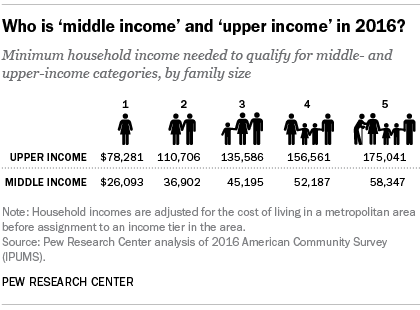
About half (52%) of American adults lived in middle-class households in 2016. This is virtually unchanged from the 51% who were middle class in 2011. But while the size of the nation’s middle class remained relatively stable, financial gains for middle-income Americans during this period were modest compared with those of higher-income households, causing the income disparity between the groups to grow.
The recent stability in the share of adults living in middle-income households marks a shift from a decades-long downward trend. From 1971 to 2011, the share of adults in the middle class fell by 10 percentage points. But that shift was not all down the economic ladder. Indeed, the increase in the share of adults who are upper income was greater than the increase in the share who are lower income over that period, a sign of economic progress overall.

Financially, middle-class households in the U.S. were better off in 2016 than in 2010. The median income of middle-class households increased from $74,015 in 2010 to $78,442 in 2016, by 6%. Upper-income households (where 19% of American adults live) fared better than the middle class, as their median income increased from $172,152 to $187,872, a gain of 9% over this period. Lower-income households (29% of adults) experienced an income gain of 5%, about the same as the middle class. (Incomes are adjusted for household size, scaled to reflect three-person households, and expressed in 2016 dollars.)
But, recent gains notwithstanding, the median income of middle-class households in 2016 was about the same as in 2000, a reflection of the lingering effects of the Great Recession and an earlier recession in 2001. The median income of lower-income households in 2016 ($25,624) was less than in 2000 ($26,923). Only the incomes of upper-income households increased from 2000 to 2016, from $183,680 to $187,872.
The widening income gap between upper-income households and middle- and lower-income households this century is the continuation of a decades-long trend. In 1970, the first year covered by earlier Pew Research Center analyses, the median income of upper-income households was 2.2 times the income of middle-income households and 6.3 times the income of lower-income households. These income ratios increased to 2.4 and 7.3 in 2016, respectively.

Are you in the American middle class?
Find out with our income calculator.
Our newly updated calculator lets you find out which group you fit in, first compared with other adults in your metro area and among American adults overall, and then compared with other adults in the U.S. similar to you in education, age, race or ethnicity, and marital status.
A recent Pew Research Center analysis also found that the wealth gaps between upper-income families and lower- and middle-income families in 2016 were at the highest levels recorded. Although the wealth of upper-income families has more than recovered from the losses experienced during the Great Recession, the wealth of lower- and middle-income families in 2016 was comparable to 1989 levels. Thus, even as the American middle class appears not to be shrinking (for now), it continues to fall further behind upper-income households financially, mirroring the long-running rise in income inequality in the U.S. overall.
The period from 2011 to 2016 encompasses much of the economic expansion following the Great Recession of 2007-09. But the recovery has been slow (the slowest in modern times) and that may help explain the lack of movement of adults into upper-income households during this period. The nation’s gross domestic product (GDP) per capita did not return to its pre-recession peak (near the end of 2007) until the latter half of 2013. Likewise, the median income of U.S. households took until 2016 to return to where it stood prior to the start of the Great Recession in December 2007.
Download our tables on the middle class in U.S. metropolitan areas and states.
The share of adults who are middle class varies widely across U.S. metropolitan areas. The estimated share was highest in Sheboygan, WI, where 65% of adults lived in middle-income households in 2016, and it was the lowest in Laredo, TX, where 39% of adults were in middle-income households. The 10 areas with the highest concentrations of middle class adults are located in the Midwest or the Northeast, with the exception of Ogden-Clearfield, UT. These areas are also more reliant on manufacturing than the nation overall. (See our earlier analysis of U.S. metropolitan areas for more detail on the characteristics of these areas.)

The metropolitan areas with the largest shares of adults in upper-income households are mostly in the coastal areas of the Northeast and California. They tend to be in high-tech corridors, such as Boston-Cambridge-Newton, MA-NH, or in financial and commercial centers, such as Hartford-West Hartford-East Hartford, CT. San Jose-Sunnyvale-Santa Clara, CA, where 32% of adults were upper-income, led among all areas in 2016. The area with the smallest share who are upper income is Lewiston-Auburn, ME (8%).
The metropolitan areas with the largest shares of lower-income adults are located primarily in the Southwest, with several on the southern border, such as McAllen-Edinburg-Mission, TX, and include farming communities in central California, such as Fresno, CA. In Laredo, TX, about half of adults (49%) lived in lower-income households in 2016, the highest share in the country. Ogden-Clearfield, UT, among the largest middle-class communities, also had the lowest share of lower-income adults (19%) in 2016.

In our analysis, “middle-income” Americans are adults whose annual household income is two-thirds to double the national median, after incomes have been adjusted for household size. In 2016, the national middle-income range was about $45,200 to $135,600 annually for a household of three. Lower-income households had incomes less than $45,200 and upper-income households had incomes greater than $135,600 (incomes in 2016 dollars).
Our interactive calculator lets you find out which group you are in based on your income, your household size, where you live and the cost of living in your area.
About this analysis
This analysis encompasses 260 of some 380 metropolitan areas in the United States, as defined by the Office of Management and Budget. The 260 metropolitan areas included are the maximum number of areas that could be identified in the Census Bureau data used for the analysis (the Integrated Public Use Microdata Series, or IPUMS). Together, these areas accounted for 79% of the nation’s population in 2016.
A metropolitan area consists of at least one urbanized area with a population of 50,000 or more people, plus neighboring areas that are socially and economically integrated with the core. Metropolitan areas may cross state boundaries, such as the Washington-Arlington-Alexandria, DC-VA-MD-WV, area.
“Middle-income” Americans are adults whose annual household income is two-thirds to double the national median, after incomes have been adjusted for household size. In 2016, the national middle-income range was about $45,200 to $135,600 annually for a household of three (incomes in 2016 dollars). The same standard is used to determine the status of households in all metropolitan areas after their incomes have been adjusted for the cost of living in the area.
The cost-of-living adjustment for an area was calculated as follows: Jackson, Tennessee, is a relatively inexpensive area, with a price level that is 17.9% less than the national average. The Hawaii metropolitan area known as Urban Honolulu is one of the most expensive areas, with a price level that is 24.4% higher than the national average. Thus, to step over the national middle-class threshold of $45,200, a household in Jackson needs an income of only about $37,150, or 17.9% less than the national standard. But a household in Urban Honolulu needs a reported income of about $56,250, or 24.4% more than the U.S. norm, to join the middle class.
The metropolitan area cost-of-living adjustment is based on price indexes published by the U.S. Bureau of Economic Analysis. These indexes, known as Regional Price Parities, compare the prices of goods and services in a metropolitan area with the national average prices for the same goods and services.
The national estimates presented in the analysis encompass the U.S. adult population, including people outside of the sample of 260 metropolitan areas.
The Census Bureau’s 2016 American Community Survey was conducted from January 2016 to December 2016. Respondents were asked to report their income received in the 12 months before the survey date. In principle, the 2016 ACS includes income data from a total of 24 months, from January 2015 to December 2016. Estimates for earlier years are from the Current Population Survey, Annual Social and Economic Supplements. The income data in these surveys pertain to the preceding calendar year. Thus, the assignment of adults to an income tier in, say, 2011 is based on their household income in 2010.
Differences between numbers or percentages are computed before the underlying estimates are rounded. Estimates may not sum to 100% due to rounding. Additional details on the methodology are available in our earlier analyses.
